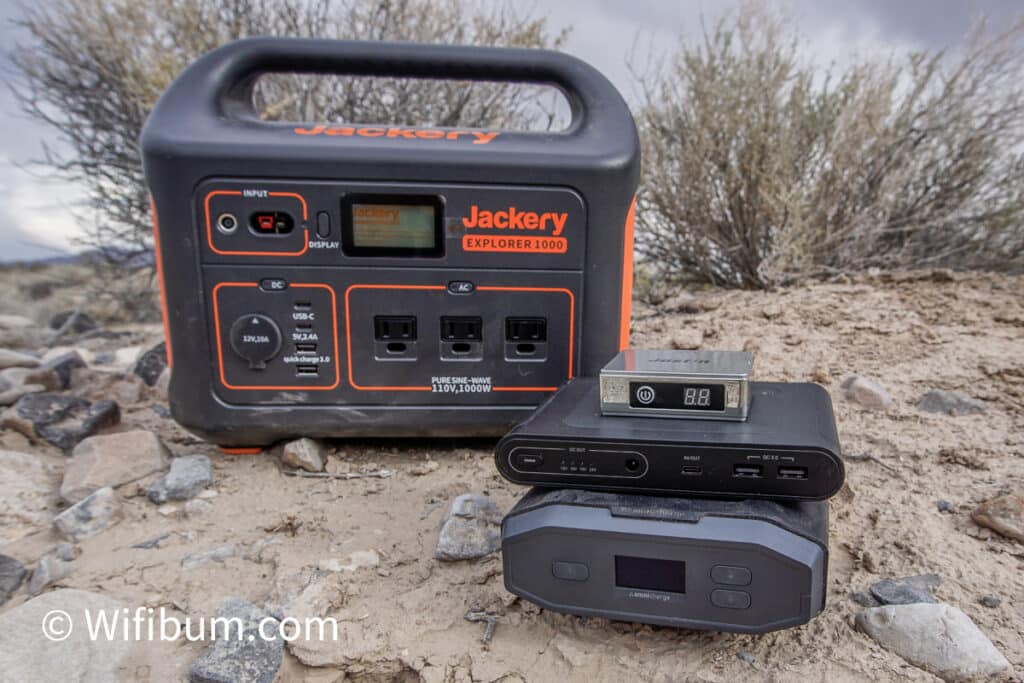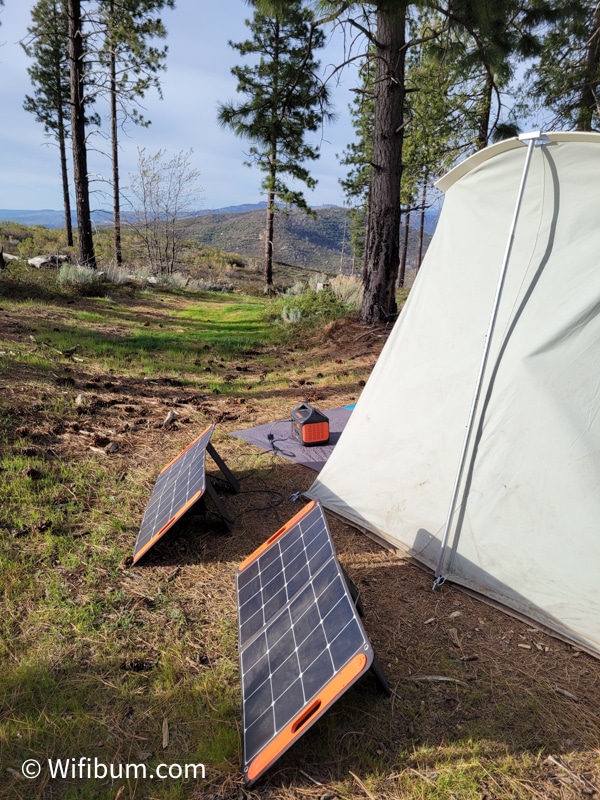Learning how to charge your laptop and phone while camping seems counter-intuitive. You’re supposed to be enjoying nature!
However, the reality is, we want our devices charged to take pictures, safety, entertainment, and stay in touch with the outside world when required.
I have spent many summers working while camping in remote areas and charging my laptop and phone were a key priority.
1. Choose a Campsites with Electric Hook Ups
Choosing a campsite with electric hook ups is an easy way to get a power source. However, you have to pay extra for it and not all campgrounds have them available.
If you’re dispersed camping with no amenities, you’ll have to use a portable power bank or power station.
2. Use a Portable Power Bank to Charge Your Phone
Portable power banks are great for camping and charging small electronics.

I use a variety of them, but Anker and Omnicharge (review) make them in all shapes and sizes.
Solar Phone Chargers
Solar powered phone cases may be an option in the future as well. They also sell power bricks with solar panels on one them.
3. Portable Power Stations for Laptops
I write extensively on portable power stations because they are great for powering my adventures. They allow me to work remotely and be off the grid.
People may frown upon working while camping, but if it allows you to take longer trips and be outside more, I see that as a positive!
4. Solar Panels with a Solar Generator to Charge Your Electronics
When you’re camping off-grid and you need power for days or weeks, using solar panels to charge your laptop and phone may be the solution you need.
I use two 100W solar panels to charge my Jackery 1000 to give me enough power to work remotely for weeks at a time. This works especially well in the western U.S. where there summers are full of reliable sunshine.

5. Charge Gear at Coffee Shops, Restaurants, and Public Spaces
In some cases, it makes sense to charge your laptop and phone at coffee shops, restuarnats, and public spaces like libraries.
I tend to charge my gear while I work remotely from a library. Some prefer coffee shops or while they are out eating.
Coffee shops and cafes can be very busy in certain areas or at certain times, so I tend to avoid them for working more than an hour or two so I’m not taking up space for others to enjoy. Most libraries have ample space to spread out and charge electronics.

How to Save Energy While Camping: Use Less Power
To avoid needing to upgrade to a larger portable power station, you can try to save and conserve energy so you don’t need to charge your devices as much.
1. Turn off GPS and Maps
Using apps that use GPS like Google Maps, Strava, GaiaGPS, etc are going to drain your battery faster. Ensure you turn them off and you’re not running your GPS actively in the background.
2. Use Airplane Mode Especially in Areas with Sparse Service
If you’re in the middle of nowhere, your phone will use more energy searching for a signal. Switch it to airplane mode, and you’ll notice your battery lasting way longer.
3. Turn Your Laptop or Phone’s Brightness Down
Dim your laptop and phone screens to conserve power while camping. It’s a major factor in how fast your phone battery drains.
It also helps bugs from flying around your face if you have your screens dimmed at night.
4. Limit Background Applications
Clear those apps! There are times in the day when you may have 10+ apps running in the background, slowly draining your batteries.
5. Minimize Multimedia Use Such as Watching Videos or Playing Games
Watching Netflix, football, or YouTube are all battery drains for laptops and phones. When you’re camping, try to switch to a less power-intensive form of entertainment such as a book.
In a nutshell, camping doesn’t mean cutting ties with your electronic devices. It’s all about striking the right balance. With some planning and energy conservation, you can enjoy the best of both worlds. Happy camping, and may your batteries always be full!
My Recommendation
If you’re only powering your phone and light laptop usage, go with Anker or Omnicharge.
If you’re powering your laptop, phone, and other devices for long periods of time, get something larger. Read my comprehensive article on the best portable power stations. Most will be fine with a power station in the 250Wh to 500Wh capacity.
